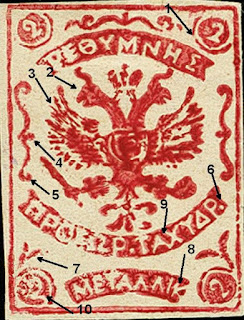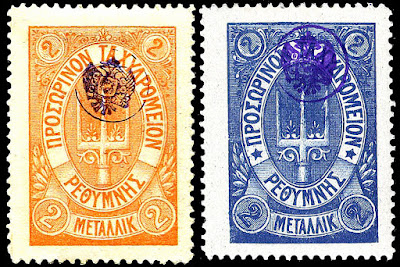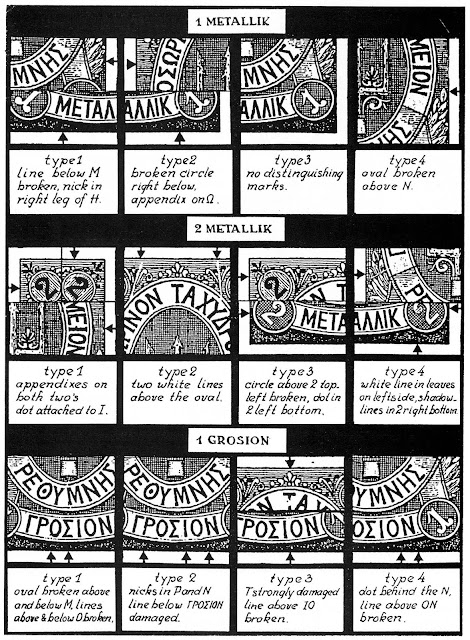Russian Occupation
The Crete Occupation Part 1 Here
The Russian Governor decided to copy the British success and decided to establish a postal service in the Russian sector. On the April 28, 1899 the decree was issued to start the service on May 1st. This postal service closed on July 29, 1899.
The main post office was in Rethymnon.
2 stamps were produced in denominations of 1 & 2 Metallik. 1 Metallik for newspapers, 2 for regular letters and 3 for a registered letter.
The stamps were made with a handstamp on a sheet of 100 stamps and very poorly placed despite there being pencil guide line that appear on many.
The issued stamps were the 1 M. blue and the 2 M. rose to red. The rose was soon changed to black. Later, the 1 M. blue was changed to green and the French text was changed into Greek.
The main post office was in Rethymnon.
2 stamps were produced in denominations of 1 & 2 Metallik. 1 Metallik for newspapers, 2 for regular letters and 3 for a registered letter.
The stamps were made with a handstamp on a sheet of 100 stamps and very poorly placed despite there being pencil guide line that appear on many.
The issued stamps were the 1 M. blue and the 2 M. rose to red. The rose was soon changed to black. Later, the 1 M. blue was changed to green and the French text was changed into Greek.
A control mark (shown right) was applied on the corner of 4 adjacent stamps. However some stamps (uncommon) are without it.
Note that the outer ring is thick and the eagle is displaced to the left. The initial color was violet and later blue, A black control is apparently a fake.
Full forgeries also have blue control marks.
The job of printing the stamps one by one was given to the Russian soldier Alexander Sokhatine.
For reasons unknown, he strayed from using the accepted colors and made stamps with in different colors using the original dies and applied the original control marks and postal cancellations.
These stamps are known as "Sokhatine" stamps and the following is a listing:
1 Metallik violet
1 Metallik blue
1 Metallik violet
2 Metallik grey lilac
2 Metallik blue
2 Metallik violet
2 Metallik green
Genuine Stamps
The top word is generally unfinished especially the last letters. Some do show a better print.
Note the M is very crude and the space before and after the T
The eagle and crest have many breaks and white spaces.
Note the shape of the lower letters, the tall ET and small A, the arms of the K.
The control mark generally appears and is violet/purple on the 1M.
Note that the outer circle of the control is much thicker that the inner. This is not the case in almost all fake cancels
The genuine 2M characteristics:
The color varies from rose to reds and brown
1. The break in the 2 frame appears fairly consistent
2. The eye is generally visible and the beak is open
3. There are about 14 feather tips - forgeries much less or just a blob
4. The round shape is attached to the scroll
5. The bottom end is similar to the top end with less curve.
6. There is a dot after the last letter
7. Both branches are basically equal in length. The left twig is much smaller than the right one
8. Long branch on the K
9. The AX are joined
10. The 2 is attached to the frame
Genuine stamps
Second printing originals
First printing genuine stamps showing the pencil alignment grid lines.
NOTE the top and bottom letters - forgeries rarely have top white areas and uneven letters
 |
| A rare block with the control mark - the pencil guide lines are visible |
Forgeries
They are plentiful but the even letters and the control mark give most away
The left one has clear printing and fairly even letters
The right one has many of the genuine features missing. The dot separated from the side scrolls is a clear clue.
Fournier Geneva Collection
A diversity a forgeries
Some may originate from the Sokhatine Bogus issues
RETV instead of RETY
TIME instead of TIMB
Short A in METALIK
 |
| Partial cancel from the Fournier album |
Sokhatine Bogus Reprints
Although sometimes listed as "unofficial" and since none apparently saw postal use, they are nothing more than "bogus" stamps.
The Sokhatine 1M are printed in violet & blue, the 2M lilac, violet, blue and green
Below are probable Sokhatine bogus stamps
The First Lithographed Issue of 27.5.1899
Because printing the stamps one by one was too long-winded, the postal authorities decided to order postage stamps at the Athens printing office of Grundman & Stangel.
The first issue was ordered from Grundman & Stangel (as with the British). It came in 3 values but possibly for philatelic sales, each denomination came in 6 colors. rose, blue, green, orange, lilac and yellow. Some rare black ones can also be found but from an unknown source.
The first Russian issue sold out very quickly and a new set was ordered from the same printers with the same denominations but only 4 colors, blue, rose, green and violet.
The second print run was much smaller than the first with corresponding higher CV’s.
As the original stones were destroyed, new ones with minor changes were made.
The differences:
In the second issue
1. Stars have been added in the oval
2. The bottom numerals are no longer all white
3. The circles around the top numerals are now one solid line
Both issues are perf 11.5 Imperfs are fairly common in the second series, most are proofs but a few were sold at the P.O.
A good time to note that they are both off center. This is fairly common for the genuine stamps while the forgeries are well centered.
The genuine stamps come in 4 types for each value so plating them is relatively easy. The forgeries cannot be plated
Left, most but not all are found with the double eagle control mark with the eagle off center to the left.
Center, rarely some will be stamped with the Cretan Control mark
Right, the genuine Rethymon Postmark. Note the narrow inner circle and the bottom design, elements that fail in the forgeries.
 |
| 2nd printing proof |
Samples of genuine types
In the first printing stones of 20 stamps were made by multiplying a transfer of 4 stamps 5 times. The 4 types are shown below. Charts were provided by a stamp forum member
 |
| Type 2 & 4 |
 |
| Type 4 & 3 |
 |
| Type 3 & 4 |
In the second printing stones of 32 stamps were made by multiplying a transfer of 4 stamps, 8 times. Charts were provided by a stamp forum member
 |
| Type 2 & 4 |
 |
| Type 1 & 4 |
 |
| Type 1 & 4 |
 |
| Block with Type 1 & 2 |
 |
| Block with Type 3 & 4 |
Forgeries
To recap some of the key elements of forgeries.
1. They tend to be better centered than originals
2. The control mark (almost 12 mm) tends to be complete and the eagle is well centered. In the original (11.5mm) it tends to be incomplete and the eagle is offset to the left
3. The postmark has a single outer ring, the original has 2 with the inner one being thin
4. Perforations are both 11.5 but tend to be neater in the genuine
5. All the forgeries cannot be plated while originals can be plated into the 4 types
Forgeries
NOTE that the forgeries tend to have rough perfs
References
Counterfeits of the 1898 provisional 20 parades stamps of the the British post office in Crete, William R. Liberman (1973)
The counterfeits of the first six issues of Crete - Chas. S. Thompson 1942
The Stamps Of Crete. Papaioannou, Angelos, 2001
Postage stamps of Crete, Poole, B.W.H. (Bertram William Henry)
Comparative Stamp Forgery Identification Site - Claighorn 2008
Forgery CD1 - Klaseboer 2019
Focus on Forgeries - V. Tyler
Vade-Mecum - Seranne Guide
Crete: Its Postal History and Stamps. Lewis, H. L. 1961
Rossica Journals
Claighorn Comparative website
Various forums (especially members of the Russian forum) online auctions and in particular




















No comments:
Post a Comment
THANK YOU for the feedback. Your comment will be reviewed and appear on this blog within 24 hours
Do you have any pic to share? Use this code [img]your-image-url-here[/img]